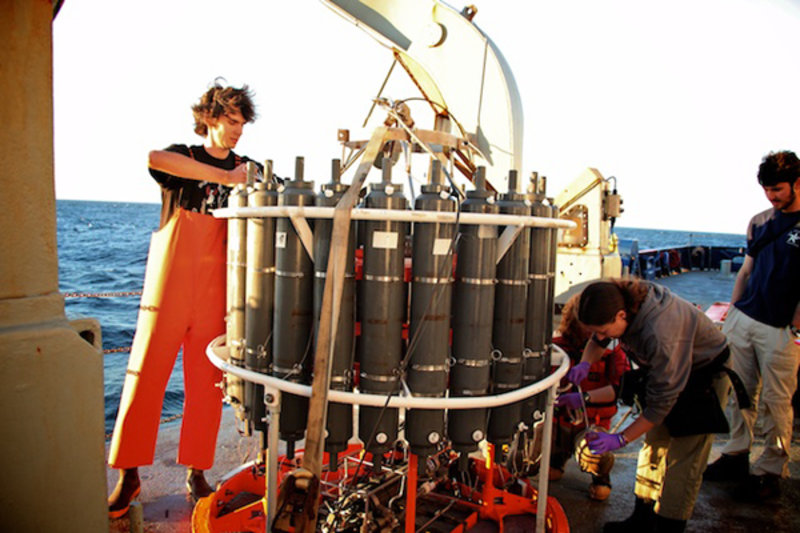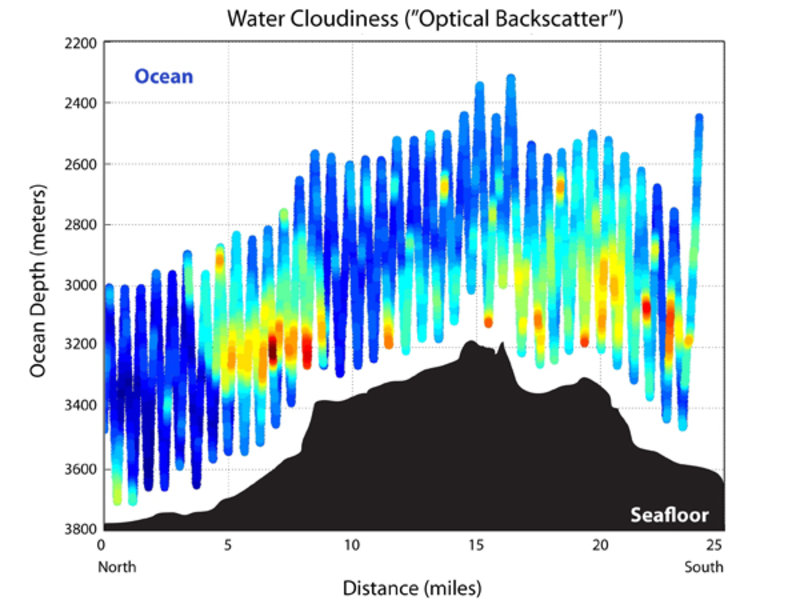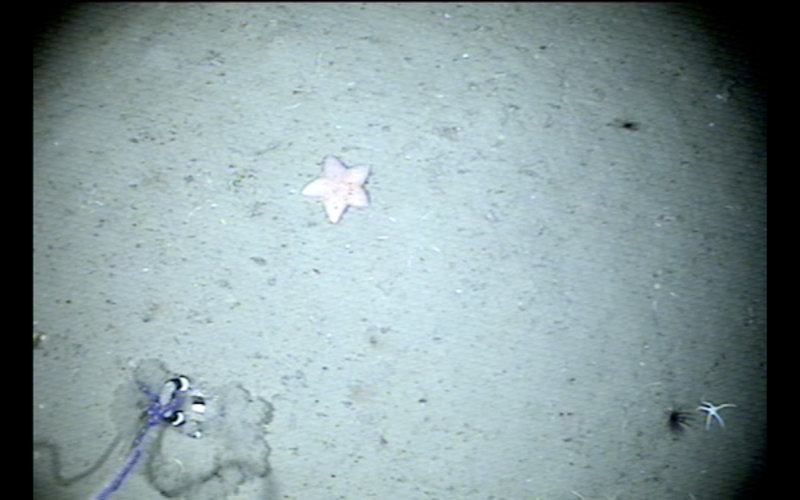
By Benjamin Grupe, Scripps Institution of Oceanography
March 2, 2010
Being a rather tall person, I often am asked how I like life at sea when ships are built for people shorter than me. Measuring in at 6 foot, 6 inches (2 meters), I will admit that there are a few difficulties. The most obvious danger is to my head: the height of most of the doorframes on the research vessel (R/V) Melville is around 6 ft, 2 in (1.86 m). Needless to say, I am getting really good at remembering to duck under doors and on stairways! My bed is too short, but I get great rest because I find sleeping on a rocking boat to be very soothing (even if my feet hang off the end of the mattress). I’m even comfortable at my short desk, because I have used metal braces and screws to raise my microscope by several inches.

Figure 1. Ben Grupe (left) prepares the conductivity, temperature, depth (CTD) bottles for deployment. This is one instance when being tall comes in handy. Normally, scientists have to climb onto the white frame to cock the bottle caps. As the CTD is lowered into the ocean, a computer monitors the data and orders bottles to snap shut, collecting water samples from different depths. Image courtesy of INSPIRE: Chile Margin 2010. Download image (jpg, 107 KB).
As it turns out, there are actually a few advantages to being tall on an oceanographic cruise. For one, I’m able to cock the conductivity, temperature, depth (CTD) bottles quickly, because I can set the center latches without climbing the frame (figure 1). I am getting really good at using my long, skinny arms to reach through the multi-core netting (so I can attach a part) or to reach down with a pole to hook tag lines of equipment coming out of the ocean. So, being tall on a ship is not nearly as unfortunate as it might seem.
I awoke this morning expecting our sixth day at sea to begin with our second multicore collection. However, our plans had changed while I was sleeping, thanks to data collected with the CTD tow-yo on February 28. The optical backscatter sensor on the CTD detected many particulates (floating “stuff” in the water) about 3.2 kilometers (2 miles) deep in the ocean, usually found about 200 to 400 m (656 to 1,312 ft) off the bottom (figure 2). Since a hydrothermal plume often creates this pattern, we decided to try another tow-yo to see if this clue led us to a vent. Unfortunately, we never did find the source of this layer of particulate matter, and the water we collected in the CTD bottles did not contain the chemical elements that would point to hydrothermal activity. And we thought we were so close . . .

This graph shows the optical backscatter data from the second tow-yo above a spreading center. Reds and oranges show where the water was cloudier, while blues indicate mostly clear water. A hydrothermal plume could increase the amount of particular matter at these depths, making the water cloudy, but so could many other things...like earthquakes, perhaps? Image courtesy of Dana Yoerger, modified by Benjamin Grupe. Download image (jpg, 97 KB).

This image was picture taken by a video camera attached to the bottom of the multicorer. It shows several echinoderms, including a sea star and brittle stars, and crinoids (sea lilies). While we did not find a methane seep, the camera was towed above the seafloor for two hours, giving us lots of information regarding the animals that live on this unexplored section of Chile’s continental margin. Image courtesy of INSPIRE: Chile Margin 2010. Download image (jpg, 62 KB).
Our hopes were raised again this afternoon. While passing near several underwater mounds, we thought the echo-sounder might be sensing methane bubbles. Again, we collected water with the CTD and used the video-guided multicorer system to inspect the benthic (bottom) habitat. This time we found methane in the water, so we were on the right track! Unfortunately, most of the methane was in a layer about 300 m (975 ft) above the bottom, so we still don’t know exactly where it was coming from. And while the video camera gave us more great images of the benthic community, we did not observe the types of animals that we typically find near methane seeps (figure 3). Tomorrow, we plan to continue searching for seeps around the triple junction (hopefully with increased luck).
Thank you to everyone who has expressed concern for all of us on board following Saturday’s earthquake. We are fine, but the country and people of Chile have a long road to recovery. If you are interested in contributing to the Chilean Red Cross, which is directing relief efforts, please contact finanzas@cruzroja.cl.